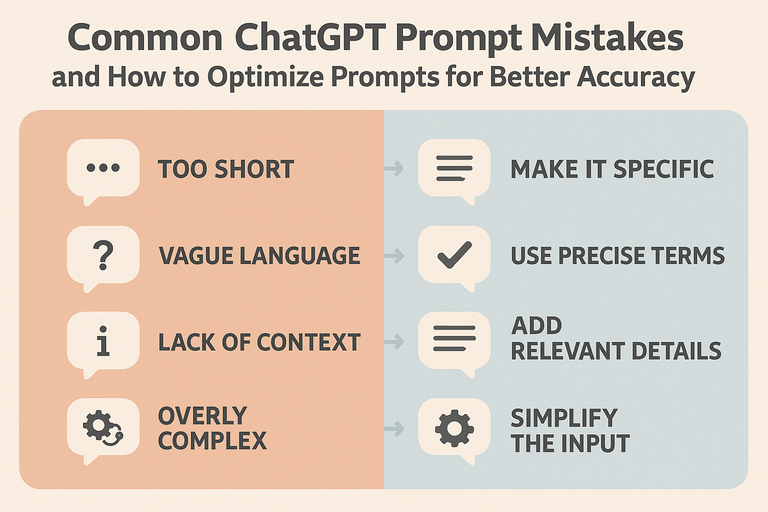Common ChatGPT Prompt Mistakes: Troubleshoot, Optimize & Improve Accuracy
Estimated reading time: 6 minutes
Key Takeaways
- Identify and correct common prompt mistakes like insufficient context, prompt overload, and word count issues.
- Understand why prompts fail, including AI hallucinations, technical limitations, and formatting errors.
- Use a structured troubleshooting checklist to refine your prompts.
- Optimize prompts with reusable templates and clear instructions.
- Improve accuracy by adding specificity, enriching context, and testing variations.
1. Understanding Common ChatGPT Prompt Mistakes
Insufficient Context
When users provide minimal information, ChatGPT can only generate generic responses. For example, asking “How do I reduce stress?” will yield basic, non-personalized advice.
Instead, structure your prompt like: “Act as a mindfulness teacher. Give me a short daily routine I can do in 10 minutes or less to reduce work-related stress during lunch breaks.”
Prompt Overload
Overwhelming ChatGPT with too much information or unclear instructions leads to confused responses. For instance, dumping large blocks of code without specific questions or error details and asking “What’s wrong?” makes it difficult for the AI to provide targeted solutions. For advanced prompt roles, see Remote AI Marketing Prompt Engineer.
Word Count Issues
ChatGPT often struggles with adhering to specified length constraints. Without clear word count parameters, you might receive outputs that are either too brief or excessively long.
2. Why ChatGPT Prompts Fail
Hallucinations & Overconfidence
- AI hallucinations occur when ChatGPT generates confident but incorrect responses.
- The system may present fabricated information as fact.
- Lack of uncertainty expression in responses compounds the issue.
Technical Limitations
- API errors can interrupt responses.
- Character limits may truncate important information.
- Connection timeouts can affect long-form content generation.
Formatting Failures
- Complex formatting instructions may be ignored.
- Code generation often faces structural issues.
- Table and list formatting can break down.
3. Troubleshooting ChatGPT Prompts
Effective troubleshooting requires understanding the six essential components of a well-crafted prompt:
- Role/Persona Assignment – Clearly define ChatGPT’s role (e.g., “Act as a senior Python developer”).
- Task Definition – Specify exactly what needs to be accomplished.
- Step-by-Step Instructions – Break complex requests into manageable steps.
- Context & Constraints – Provide relevant background information and set clear limitations.
- Specific Goal – Define the desired outcome.
- Output Format – Specify how the response should be structured.
Prompt Troubleshooting Checklist:
- Is the role clearly defined?
- Are instructions specific and sequential?
- Have I provided necessary context?
- Is the desired output format specified?
- Are constraints clearly stated?
4. Prompt Optimization Tips
To optimize your prompts, use this reusable template structure:
- Role: [Specify the expert role ChatGPT should assume]
- Task: [Clear, specific request]
- Steps:
- [First action]
- [Second action]
- [Additional steps as needed]
- Constraints:
- [Word limit]
- [Style requirements]
- [Other limitations]
- Goal: [Desired outcome]
- Format: [Specify output structure]
Pro Tips:
- Use colons to create clear sections.
- Implement line breaks for visual clarity.
- Request uncertainty expression when appropriate.
For marketing-focused insights, see Vibe Marketing 2025.
5. Improve ChatGPT Prompt Accuracy
Specificity
Instead of vague requests, use detailed parameters. Compare:
Weak: “Give me marketing ideas“
Context Enrichment
- Provide relevant background information.
- Include specific scenarios.
- Add industry context when applicable.
Testing & Iteration
- Modify one variable at a time.
- Compare outputs across different prompt versions.
- Document successful patterns.
- Build a library of effective prompts.
Conclusion
Mastering ChatGPT prompt crafting requires understanding common mistakes, recognizing failure modes, and applying effective troubleshooting techniques. By leveraging structured templates, optimization tips, and accuracy strategies, you can significantly improve your AI interactions. Remember, prompt engineering is an iterative process—test different approaches and refine your prompts based on results.
Additional Resources
- OpenAI’s Official Prompting Guide
- Advanced Prompt Engineering Techniques
- ChatGPT API Documentation
Previous Blog Posts
- Vibe Marketing 2025: How to Connect with Customers on a Deeper Level
- How to Become a Remote AI Marketing Prompt Engineer Today
- Why Prompt Engineering Jobs Are in High Demand Right Now
FAQ
How can I provide more context in my ChatGPT prompts?
Include detailed background information, specify roles, and outline the desired outcome to guide the AI toward relevant responses.
What should I do if ChatGPT goes off topic?
Refine your prompt with clearer instructions, add constraints, or break the request into smaller steps to keep the AI focused.
How do I measure the effectiveness of my prompts?
Compare AI outputs against defined goals, use metrics like relevance and accuracy, and iterate based on feedback and performance data.
